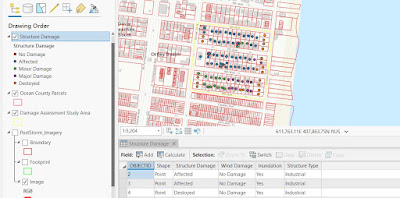This week, we evaluated several methods of interpolation for efficacy in two different example scenarios: elevation and water quality. I will first describe briefly how these interpolation methods work.
According to Esri's help documentation, IDW (Inverse Distances Weighted) operates under the assumption that objects or things close together are more similar than things farther apart. If we are interpolating what might be expected in a void, this method will assume the known data points closest to that void will be more similar that data points farther away. Each known data point has an influence that diminishes with distance.
According to Esri's help documentation on Spline interpretation, this method uses a mathematical function that attempts to create a smooth surface by minimizing overall curvature and passing through all known data points.
For elevation, we evaluated the use of Spline and IDW from known elevation data points. In this instance, Spline outperformed IDW in creating a more realistic display of the terrain. The IDW method created many potholes and areas that did not seem to fit with what a natural landscape might be like.
For water quality analysis, we evaluated the use of non-spatial analysis, Thiessen interpolation, IDW and Spline (regularized and tension). In this analysis, IDW was the most effective in presenting the data accurately and in a spatial distribution that reflects an intuitive sense of reality. This is represented in the table below:
|
Technique
|
Minimum
|
Maximum
|
Average
|
Standard Deviation
|
|
Non-Spatial
|
|
0.8
|
3.5
|
1.81
|
0.57
|
|
Thiessen
|
|
0.8
|
3.5
|
1.79
|
0.56
|
|
IDW
|
|
0.81
|
3.5
|
1.78
|
0.29
|
|
Spline
|
|
|
|
|
|
|
|
Regularized
|
-1.7
|
3.64
|
1.67
|
0.65
|
|
|
Tension
|
-9.79
|
9.64
|
1.81
|
0.76
|
Below is a representation of the most accurate method used in water quality analysis, the IDW interpolation:
And the same data represented by the regularized Spline method:
As you can see, there are some areas of contamination that are not really represented with the Spline method. Because it wants to create a smooth surface, it overpowers the more anomalous known measurements in a way that ultimately creates an inaccurate representation. It also assumes influence in perpetuity and is only cut off by the mask that we input manually.















